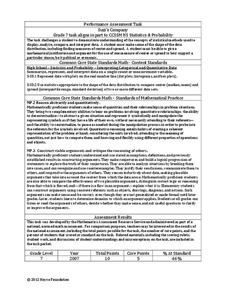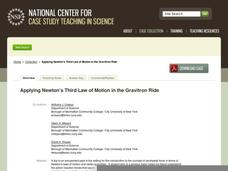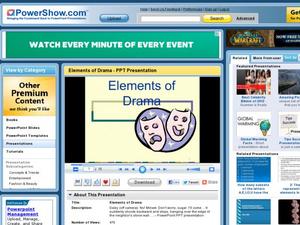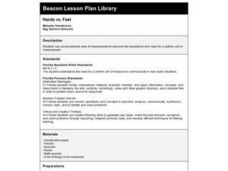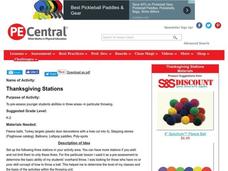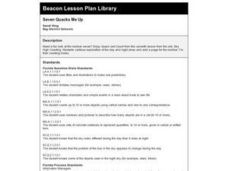Inside Mathematics
Suzi's Company
The mean might not always be the best representation of the average. The assessment task has individuals determine the measures of center for the salaries of a company. They determine which of the three would be the best representation...
Discovery Education
Wind Power
How do engineers turn something that is readily available, like wind, into energy? Scholars create a prototype of a wind turbine and attach it to a motor. They test out their prototypes and decide on their effectiveness. They also...
American Museum of Natural History
Being an Astronomer: Neil deGrasse Tyson
An interview delves deep into the life of famous astronomer Neil deGrasse Tyson.
Cornell University
The Physics of Bridges
Stability is key when building a bridge. Scholars explore the forces acting upon bridges through an analysis of Newton's Laws and Hooke's Law. The activity asks individuals to apply their learning by building a bridge of their own.
Inside Mathematics
Snakes
Get a line on the snakes. The assessment task requires the class to determine the species of unknown snakes based upon collected data. Individuals analyze two scatter plots and determine the most likely species for five...
Inside Mathematics
Population
Population density, it is not all that it is plotted to be. Pupils analyze a scatter plot of population versus area for some of the states in the US. The class members respond to eight questions about the graph, specific points and...
Curated OER
A "Teacher Appreciation Week" Card for the Teacher
Anyone can create Teacher Appreciation Week cards for their teachers. This activity is designed to be incorporated with an art class. Learners will design a card and discuss ways to show appreciation for their teacher. Resource...
Curated OER
Stochastic and Deterministic Modeling
Explore the difference between stochastic and deterministic modeling through programming. First have the class write algorithms for relatively simple tasks using pseudocode. Use the Python 2.7 program app to simulate Mendel's Pea Pod...
National Center for Case Study Teaching in Science
Applying Newton’s Third Law of Motion in the Gravitron Ride
Here is a collection of readings to be discussed in the science classroom. This one is in the form of a dialog between two boys in an amusement park, talking about the forces involved in a Graviton ride. Questions are listed at the...
Philadelphia Museum of Art
Physics at the Art Museum: Kinetic Energy, Potential Energy, and Work
Connect science, math, and art for a true interdisciplinary lesson! Learners explore simple machines in art. Through analysis with a physics app, they identify positions of kinetic and potential energy and make conclusions about work.
Teach Engineering
Nanotechnology as a Whole
It's a small (nanotechnology) world after all! The first segment of a six-part series gives an overview of nanotechnology, its principles and applications, and shares some of the engineering applications of nanotechnology. A...
Inside Mathematics
Archery
Put the better archer in a box. The performance task has pupils compare the performance of two archers using box-and-whisker plots. The resource includes sample responses that are useful in comparing individuals' work to others.
Curated OER
Elements of Drama: Vocabulary
Introduce your young thespians to the elements of drama! Key vocabulary helps them through their first week of class. The presentation outlines parts of a script, stage direction, and strategies for reading a script. Tip: The strategies...
Curated OER
International Folklore
Folklore is composed of stories that convey cultural heritage and traditions. Many types of tales are listed as well as what they portray in various contexts and situations. Give your learners a brief description or definition of...
Curated OER
Poetry Notes
Break this presentation into two or three days so as not to overwhelm your kids. Fifty-four slides is a lot of slides, but the PowerShow is well-organized, and terms are defined clearly and illustrated in examples provided. A general...
American Statistical Association
A Sweet Task
Candy is always an effective motivator! A fun math activity uses M&M's and Skittles to explore two-way frequency tables and conditional probability. The candy can serve a dual purpose as manipulatives and experimental data.
Curated OER
Hands Vs. Feet
First graders use unconventional units of measurement to discover the importance and need for a uniform unit of measurement.
Curated OER
Pumpkin Patch
Students work cooperatively during a fun, Halloween themed scavenger hunt in the gym.
Curated OER
Are You Coordinated?
First graders are introduced to a coordinate graph. They are given a graph and follow directions to place stickers in the designated blocks. They write coordinate points to identify the placement of their stickers.
Curated OER
And the Number Is
Students identify the numbers 1-10 while listening to a counting song. They practice counting items using the numbers 1-10.
Curated OER
Beginning Sounds-What sound does each picture begin with?
Students view a multimedia presentation to identify beginning sounds. In this phonics lesson, students recognize beginning sounds. Students navigate a website for addition phonics sounds.
Curated OER
Thanksgiving Stations
Pupils are assessed in their abilities in three areas--in particular throwing using Fleece balls, Turkey targets (plastic door decorations with a hole cut into it), Stepping stones (Flaghouse catalog), Balloons, Lollipop paddles, and...
Curated OER
Seven Quacks Me Up
First graders explore the day and night sky and add a page for the number 7 to their countiing books.
